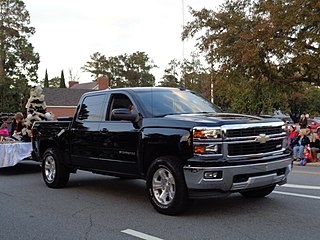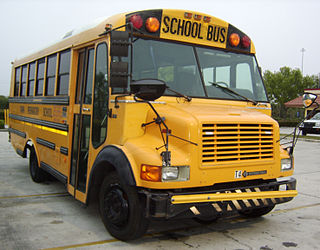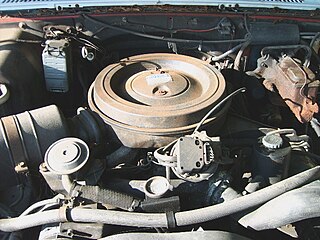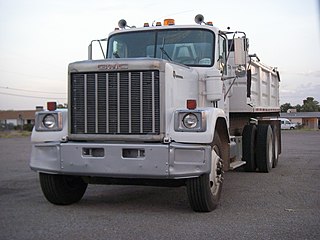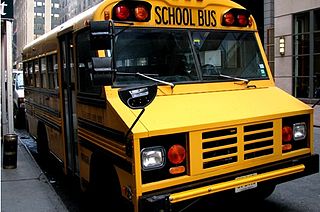| Chevrolet/GMC B-series | |
|---|---|
| Overview | |
| Type | Bus |
| Manufacturer | General Motors |
| Production | 1966-2003 |
| Body and chassis | |
| Class | Class 6-7 (Medium/heavy-duty) |
| Body style | Cowled chassis (conventional-style) |
| Chronology | |
| Predecessor | Chevrolet/GMC C/K (medium duty) |
| Successor | none Blue Bird Vision (indirect) |
The Chevrolet and GMC B-series is a series of cowled chassis that were produced by General Motors, primarily fitted with school bus bodies throughout its production. Based on the medium-duty (Class 6-7) trucks produced by the Chevrolet and GMC divisions of General Motors, the B-series was produced in three separate generations; GMC initially produced its own version separate from Chevrolet. Introduced in 1966, the B-series was redesigned in 1984 and 1992 as a 1993 model.

General Motors Company, commonly referred to as General Motors (GM), is an American multinational corporation headquartered in Detroit that designs, manufactures, markets, and distributes vehicles and vehicle parts, and sells financial services, with global headquarters in Detroit's Renaissance Center. It was originally founded by William C. Durant on September 16, 1908 as a holding company. The company is the largest American automobile manufacturer, and one of the world's largest. As of 2018, General Motors is ranked #10 on the Fortune 500 rankings of the largest United States corporations by total revenue.
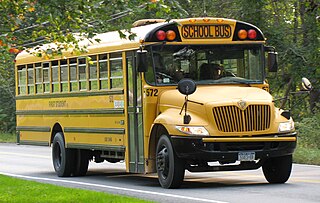
A school bus is a type of bus owned, leased, contracted to, or operated by a school or school district. It is regularly used to transport students to and from school or school-related activities, but not including a charter bus or transit bus. Various configurations of school buses are used worldwide; the most iconic examples are the yellow school buses of the United States and Canada.
Contents
- Background
- First generation (1966-1983)
- Chevrolet (1967-1983)
- GMC (1966-1970)
- Second generation (1984-1991)
- Third generation (1993-2003)
- Blue Bird CV200
- Usage by body manufacturers
- See also
- References
Following the end of a supply agreement with Blue Bird Corporation, effectively leaving General Motors without a body manufacturer with which to supply chassis, the company exited production of full-size bus chassis, producing the later GMT560 solely as a cutaway-cab vehicle. The Blue Bird Vision entered production in 2004, becoming the first conventional-style school bus produced without a second-party chassis.

The Blue Bird Corporation is an American bus manufacturer headquartered in Fort Valley, Georgia. Best known for its production of school buses, the company has also manufactured a wide variety of other bus types, including transit buses, motorhomes, and specialty vehicles such as mobile libraries and mobile police command centers. Currently, Blue Bird concentrates its product lineup on school and activity buses and specialty vehicle derivatives.

The Blue Bird Vision is a bus that is manufactured and marketed by Blue Bird Corporation in North America and exported worldwide. In production since 2003, the Vision became the first cowled-chassis bus built on a proprietary chassis designed and manufactured by the same company. While it is sold primarily in a school bus configuration, the Blue Bird Vision is also offered with various commercial and specialty seating and design configurations.
As of 2017, General Motors remains a supplier of bus chassis for school bus and commercial bus use. Currently, all examples are cutaway van chassis based on the GMT610 architecture (Chevrolet Express/GMC Savana).

Cutaway van chassis are used by second stage manufacturers for a wide range of completed motor vehicles. Especially popular in the United States, they are usually based upon incomplete vans made by manufacturers such as FCA US LLC, Ford Motor Company, and General Motors which are generally equipped with heavier components than most of their complete products. To these incomplete vehicles, a second stage manufacturer adds specific equipment and completes the vehicle. Common applications of this type of vehicle design and manufacturing includes small trucks, school buses, recreational vehicles, minibuses, and ambulances. The term "cutaway" can be somewhat of a misnomer in most of the vehicle's context since it refers to truck bodies for heavy-duty commercial-grade applications sharing a common truck chassis.





